←
ペイン - ティング
絵はフィジカルなもので、絵そのものがその場と時間を提供します。
絵はそこにしかないのです。それは極めて現実的なものです。
そしてさらには事実的なものです。絵は事実になった時の衝撃です。その衝撃は私にとって大抵が痛みです。
私にとって、この痛みがなければ表現とは言えません。
この場合の痛みとは、そのまま自由のことを指しています。
(2023 年 9 月)
Pain-ting
The painting is physical; the painting itself provides the place and time.
The painting is only there. It is very real.
And furthermore, it is a fact. A painting gives a shock when it becomes a fact. That shock is mostly pain for me.
For me, without this pain, it is not an expression.
Pain in this case means freedom.
(September 2023)
[by automatic translation]
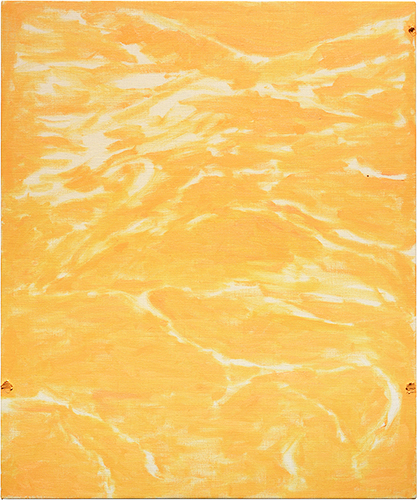
EINFACH NUR BETRACHTEN
Neue Fotografie
https://neuefotografie.com/ueber-das-sehen-von-motonori-inagaki/
Wenn man einen Ort immer wieder aufsucht und fotografiert, lösen sich die Aufnahmen von seiner Zeitlichkeit und dem Ortsbezug. Ich verstehe dieses Vorgehen nicht als dokumentarischen Ansatz, sondern einfach als Betrachtung. Bei mehreren Aufnahmen von einem Ort werden unterschiedliche Zeitpunkte aufgenommen. Das Verhältnis dieser verschiedenen Zeiten ist für mich ein Gleichnis für die Vielschichtigkeit der menschlichen Empfindungen und die Schwierigkeit von Vergleichen. Besteht die Geschichte der Menschheit rein aus dokumentarischen Aufzeichnungen? Wie unterscheiden wir Aufzeichnungen und Erinnerungen? Bei dieser Unterscheidung geht es nicht um das Andere oder das Eigene, sondern um eine Gleichzeitigkeit dessen im jeweiligen Individuum.
Wenn ich einen Baum gehend umkreise, aus verschiedenen Winkeln fotografiere und eine lange Zeit begleite, ist es für mich wie ein Nachspüren der Verwandlung, Verdrehung, Querbewegung und Sprunghaftigkeit der Zeit. Diese aus der Betrachtung heraus entstehenden Fotografien bedeuten für mich keine Fixierung der Zeit und des Ortes, sondern die Fortsetzung ihrer Bewegung. Diese Bilder in ihrer Leerheit und Durchlässigkeit befinden sich fortwährend in Verwandlung. Wenn sie diesen schwebenden Zustand erreicht haben, ist für mich die Arbeit daran abgeschlossen.
Video und Fotografie sind für mich eng beieinander und es passiert oft, dass ich das gleiche Motiv in beiden Medien nutze. Das Verhältnis von den miteinander verknüpften Fotos entsteht wie in einer Timeline einer Videosequenz. Meine Videos bearbeite ich nur sehr wenig. Für die Aufnahme wird die Kamera auf dem Stativ fixiert und es werden lediglich Einstellungen wie Monochrom, Slowmotion, Rückwärtsmodus oder Bilddrehung angewendet. Die Kamera als Apparat hält fest, was auf dem Bildschirm zu sehen ist und zeichnet präzise alle Informationen auf. Mit unseren Augen und unserem Bewusstsein können wir das nicht erreichen. Wir Menschen sind auf etwas Bestimmtes fokussiert, anderes sehen wir nicht und die meisten Dinge nehmen wir gar nicht erst wahr. Mit der Art und Weise meiner Video-Arbeiten versuche ich auszudrücken, was ich selbst als Mensch wahrgenommen habe.
Der Mensch strebt danach, eine Ordnung in der Welt zu finden. Andererseits bemerken wir, dass wir sie dabei zerstören. Das ist ein fortwährender unaufgelöster Widerspruch. Um die Welt in ihrer Komplexität zu erfassen, bleibt uns Menschen nur das reine Betrachten. Für mich bedeutet das vor allem ein Wechsel von einer allgemeingültigen hin zu einer individuellen Zeitempfindung. Wenn ich etwas betrachte, löse ich mich von meinen Vorstellungen und bald verschwinden auch eingeschriebene Vor-Bilder.
Übersetzung aus dem Japanischen von Thomas Neumann
(2023)
ただ眺めるということ
場所性や時間性を排した風景は、同じ場所で継続的に撮影が行われています。しかしそれは記録的なものではなく、ただの眺めとなります。ある時間と別の時間の間に生じる関係は、単純な比較ではなく人間の内面ではとても複雑なものになります。人の歴史とは、記録されたものでしょうか?それとも記憶されたものでしょうか?それとも記録や記憶ではない別のものでしょうか?それは他者と共有されることなく、それぞれの個人の中で同時進行してゆきます。
一つの樹の周りを歩き様々な角度から撮影をしたり長期間に渡る撮影をすることは、時間の転換や逆行、ねじれや飛躍を模索するためのものです。ただ眺めているだけのようなこれらの写真は、時間や場所が固定されることなく揺れ続けます。多くの余地を残した多孔的とも言えるこれらのイメージは常に別の何かに変換される準備がされています。何物にも到達しない状態こそ、私にとっての到達点になるのです。
映像は写真にとても近く、同じモチーフを使用することも多くあります。組み合わされた写真で生まれる関係性が、映像の場合は一つのタイムラインの中で生じます。映像は非常に単純な編集で制作されています。固定したカメラで撮影された風景は、モノクロ・スロー再生・逆再生・画面の天地の反転などの加工をされているのみです。カメラは画面の中を均等に、そして正確に情報をとらえます。しかし私たちの目や意識はそうではありません。私たちは何かに注目して、何かに目を背けて、そして多くのものを認識していません。私は映像を自分が認識していた状態に戻そうとしています。
人は社会の中では秩序立てて理解することを求めながら、一方ではそれを壊さずにはいられないのでしょうか。私たちは常に不公平で偏った時間の中にいるのです。複雑な内面を通して世界を捉えると、人はただ眺めることしかできなくなってしまいます。それは社会的な時間から個人的な時間に移行することを意味します。眺めることは焦点を消し去り、やがてイメージを不在にしてしまいます。
(2023年)
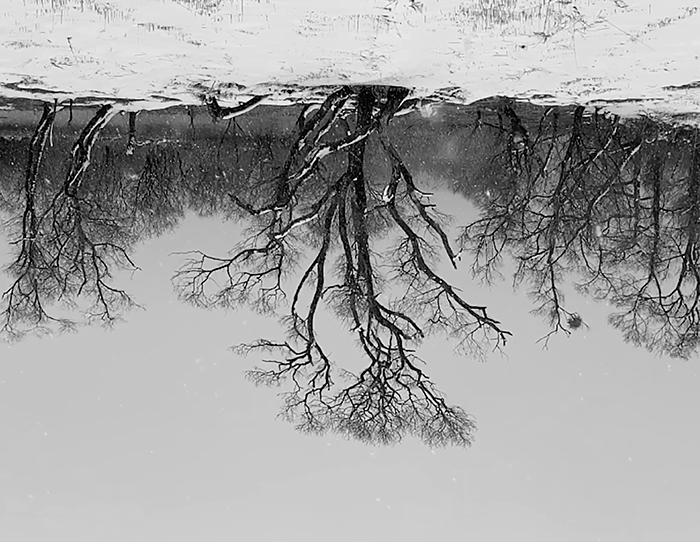
100 Jahre
I participated in the program of "PLUS-A Project for an Aging World” in Dusseldorf, German last summer.
Under the themes of “aging" , “growing old”, I thought about the time related to individual, which is different from the time related to society and science.
Maybe present is the only thing that truly exist among past, present, and future. On the other hand, there are some situations that past and future might be easy to understand and perceive.
The “present”, which moves from moment to moment, is actually the hardest thing to perceive, and it might be very difficult to clarify what exactly it is. I think in most situation, our cognition and understanding, mood and feelings remain in the past or the future when we experience present of moment.
Soaking in the memories, regretting on something happened already, dominated by something have not happened yet, looking forward to or worrying about the future, we are spending irregular time like “a long day” or “a life in a blink of an eye” while we are confused about how to understand present.
My drawings, photographs and movies are deeply related to such irregular and wavering time.
100 years are expanded, shrunk and skipping. Sometimes they turn back, being made up. Many are forgotten.
(2022)
100 Jahre(100年)
昨年の夏、私はドイツのデュッセルドルフで、PLUS-A Project for an Ageing World(高齢化社会のためのプロジェクト)に参加しました。
「高齢化」「老いること」のテーマの中で、私は社会的・科学的な一方向の時間とは異なる個人の時間について考えました。
過去や現在や未来の中で、実在しているのは現在だけであるかもしれませんが、一方で過去や未来は捉えやすく認識もしやすい場合があります。
瞬間ごとに移動していく「現在」は、実は一番認識しづらく、それが一体何なのかを確かめることがとても難しいのかもしれません。 多くの場合、現在という瞬間を過ごしながらも、認識や理解、気持ちや感覚は過去や未来にあることも多いのではないかと考えることがあります。
思い出に浸り、後悔したり、または予定に支配され、そして将来を期待したり憂いたりすること。現在をどう捉えるかに戸惑いながら、私たちは「長い一日」や「あっという間の人生」というような、歪な時間を過ごします。
私のドローイングや写真・映像はそんな歪な時間、揺らぐ時間に深く関わっています。
100年は、引っ張られ、縮められ、飛び越える。時にはひっくり返り、捏造される。多くは忘れられる。
(2022年)
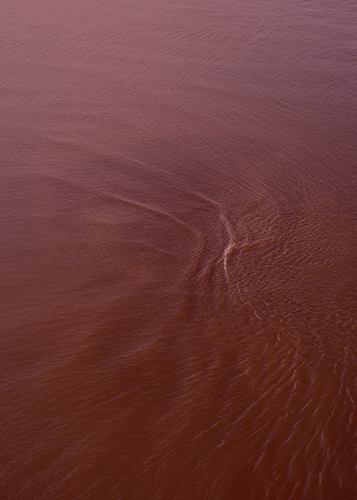
Atlas
I keep an eye on my growth and aging by continuing to draw.
I think about what I can and cannot do. I also think about what I can and cannot do more than I used to.
Now I can't draw like when I was 20 years old. Similarly, at the age of 20, I wouldn't have been able to draw like I can today.
Changes in people's lives and feelings, and their corresponding thoughts and ideas, do not always follow the time axis. Things I thought were good yesterday may seem bad today, but can often turn out to be acceptable in the future. Even if I think to have progressed, I may be backing up, or when I feel stuck, I might actually be leaping to a completely different place. Influenced by these things, I grow up and grow old. Although living closely with it, I sometimes think of time as a separate phenomenon.
Drawing becomes a field for repeating the acts of believing and doubting.
Drawing is walking, and also thinking.
This time, I shot videos on my iPhone. There is an airy and unfixed feeling to it. And that feeling is similar to the copy paper drawings I have been continuing. I create blank spaces so that the subject can move around. This may be for filling in the gaps that lie between the aforementioned time axis and my own values and beliefs. As long as space is left for the subject to move, even if I change to be a different person tomorrow, I may be able to find a different perspective on what the drawing means. In other words, it is a kind of hope that it may connect to someone in a completely different country or era.
(2020)
アトラス
私はドローイングを続けることで、自分の成長と老いを観察しています。
私は何ができて、何ができないかを考えます。同じく何ができるようになって、何ができなくなったのかということも考えます。
20歳の頃のようなドローイングはできません。同じく20歳の私が今のようなドローイングをすることはできないでしょう。
人の生活や感情、それによる思考や思想の変化は必ずしも時間軸に沿っているわけではありません。昨日良いと思っていたものが今日悪いと思ったり、それがまた将来許せたりすることもよくあることです。進んだと思っていても後退していたり、停滞していると感じても全く違う場所に飛躍していたりします。それに影響されて私は成長し、また老いてゆきます。それは時間と寄り添いながらもまた別の事象であると考える場合があります。
ドローイングは信じることと疑うことを繰り返す為のフィールドになります。
ドローイングは歩くことで、考えることです。
今回、私はiPhoneで映像を撮影しました。そこには軽く、固定されていない感覚があります。その感覚は継続されているコピー用紙によるドローイングに似ています。周りに余白を作って対象が動くようにするのです。それは先ほどの時間軸と自分の価値観や信じることがずれていることに対しての辻褄を合わせるためのものなのかもしれません。余白によって対象が動くようにしていれば、もし明日自分が別人のように変わってしまっても、また違う見方でこのドローイングの意味を見出せるかもしれません。言い換えればそれは自分と全く違う国や時代の誰かにも繋がってくれるのではないかという希望でもあります。
(2020年)
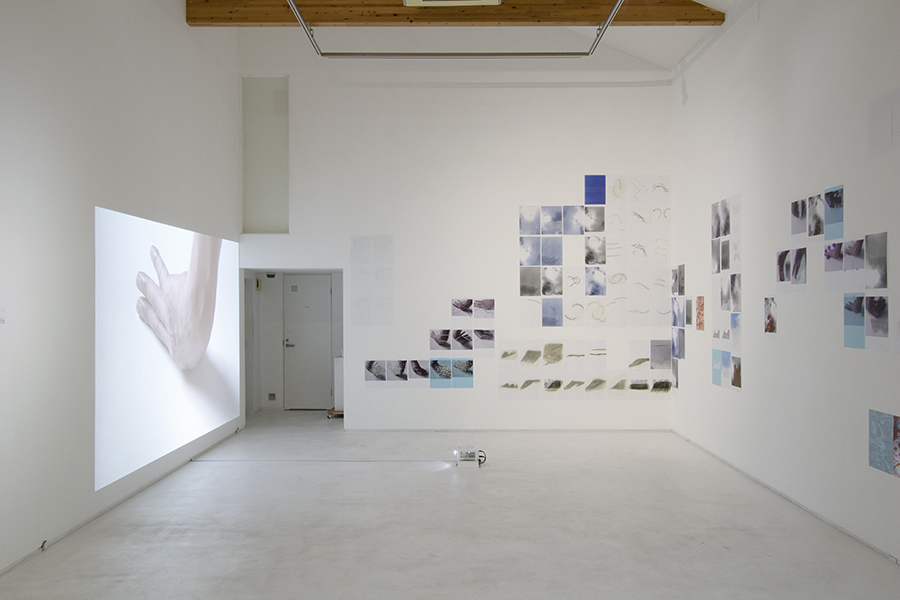
elephant
A well-known fable tells of the blind men and the elephant. Several blind men felt different parts of an elephant and discussed what kind of animal it was.
Though they had all felt the same elephant, the man who had felt its leg said it was like a tree, and the one who had felt its trunk said it was like a snake. The moral of the story is that even when people are discussing the same thing, they may assess it in completely different ways depending on their impressions, and that just grasping one small part of something does not mean you grasp its entirety.
Drawing may be similar to this groping around in the dark. I record something I have encountered, and observe and think about what it is. In my blind state, my imagination, belief, longing, doubts, disappointments, and misunderstandings all make their way into the works. For me, these small things accumulate to form a large map of an unknown territory.
I started drawing in 1992, when I was 20 years old. I've been drawing on paper of the same size on a daily basis for over 25 years. This repetition is crucial, and the format is compatible with gradually increasing complexity and freedom, depending on the amount of time spent and number of sheets used.
“I believe that drawing on paper is very important. Drawing on paper is hardly a unique medium, but it is the one that I arrived at. For me it has always been and will continue to be a new, radical, yet precise medium. It connects the self to the work very simply and yet very intimately. It is a practice that resembles walking.” (2002)
“The latest picture I’ve drawn is an accumulation of all my drawings so far, so I could say it took 21 years to produce. And the first drawing I ever did has gained new value over the years. Both of these thin pieces of paper, the first and the latest, have gained heft and complexity with time.” (2013)
If we view each drawing as a cross-section of the world, a single drawing is like the blind men’s elephant.
I believe that every drawing presents one aspect of multifarious impressions, values changing over time, and phenomena that cannot be grasped in their entirety.
It is the process of taking a nameless and seemingly indeterminate event, and assingning it a specific from.
(2018)
elephant - 象
「群盲象を評す」ということわざがあります。これは複数の盲人が一頭の象を触ってみて、象とは如何なる動物かと語ってみたという逸話に基づいています。
同じ象であっても、足を触った盲人は「木である」と言い、鼻を触れた盲人は「蛇である」と言う。「論ずる対象が同じであっても、その印象も評価も人それぞれに異なる」という意味であり、また「わずか一部分を取り上げたところで、その事象の全てがわかるわけではない」という意味でもあります。
ドローイングはこれに似た行為かもしれません。触れたものを記し、それが何かと観察し、考えます。盲目の中で、想像すること、信じること、憧れ、疑いや失望、勘違いのすべてはこれらの絵の中にあります。その蓄積でわたしの大きな地図はつくられます。
ドローイングを描き始めたのは1992年、20歳の時でした。わたしは同じ大きさの紙に25年以上、日常的にドローイングを繰り返してきました。この繰り返しはとても重要で、時間や枚数によって次第に複雑さを重ねていくことと、同時に自由になることが両立されています。
「私は紙のドローイングが非常に大切である。紙にドローイングという方法は、特別な方法ではないと思うが、私はこの方法を発見した。私にとってはいつも新しく、過激で、的確な方法であり、また存在であり続けている。とても簡素に、そして丁寧に自分と作品をつなげる。それは歩くことに似ている」(2002年)
「最新の一枚の絵は、それまでのドローイングすべての蓄積であり、ある意味21年間かけて描いたものだといえます。そして最初の一枚は、いままでの時間をかけて価値付けされてきたものです。この薄い紙の絵はどちらも時間の重厚さと複雑さを孕んでいるのではないかと思います」(2013年)
これらのドローイングが世界を探る一断面であるということから転じて、実は一枚のドローイングが、一頭の象そのものでもあります。
一枚のドローイングが、異なる印象や変容する価値、把握できない事象の一つの対象としてあるのではないかと思います。
それは不確かと思われてしまう名前のない事象に一つの象(かたち)を与えることです。
(2018年)
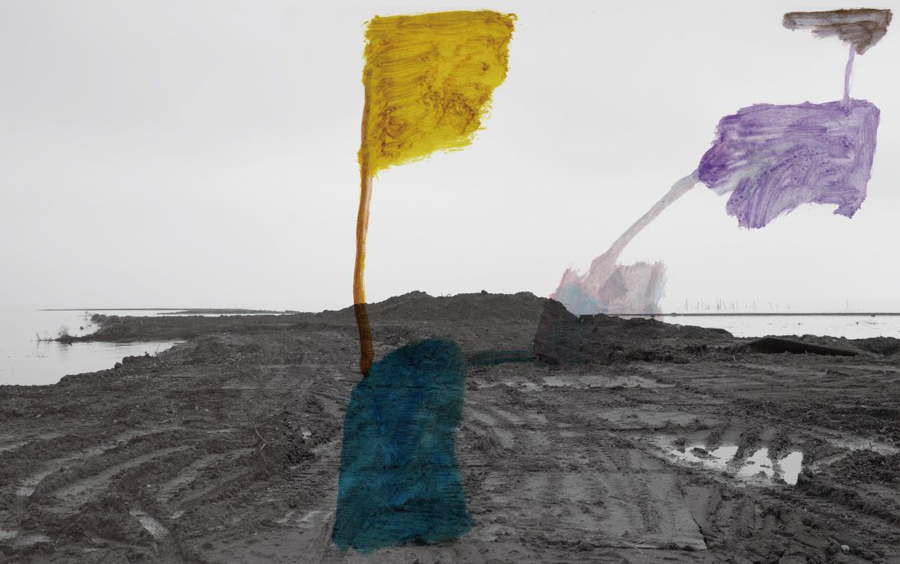
←
motonoriinagaki.com
Copyright © 2012 Motonori Inagaki All Rights Reserved.




